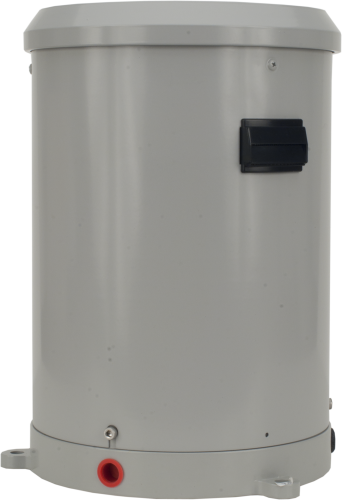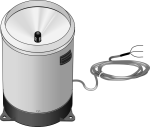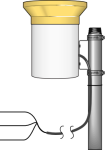
Overview
The TB4, manufactured by Hydrological Services, is a high-end tipping bucket rain gage that has an 8 in. orifice and measures rainfall in 0.01 in. increments. It is ideal for locations where intense rainfall events may occur. This tipping bucket is compatible with all Campbell Scientific dataloggers, and is used in environmental monitoring applications.
Read MoreBenefits and Features
- Accuracy is ±3 percent at high precipitation rates of 500 mm/hr
- More accurate measurement of high-intensity precipitation
- High precision—tips at 0.01-in. increments
- Compatible with most Campbell Scientific data loggers
Images



Technical Description
The TB4 funnels precipitation into a bucket mechanism that tips when filled to its calibrated level. Each tip is marked by a dual reed switch closure that is recorded by a data logger pulse count channel. After measurement, the water drains through two orifices (accepts 12 mm tubing) in the base, allowing the measured water to be collected in a separate container.
The TB4 contains an internal siphon mechanism that causes rain to flow at a steady rate to the tipping bucket mechanism (regardless of intensity). The siphon allows the sensor to make accurate measurements over a range of 0 to 50 cm per hour.
Compatibility
Mounting
The base of the gage is supported by three legs. A CM240 Leveling Base and Mount or a user-supplied baseplate with leveling capability is recommended. The CM240 may be attached to a CM300-series mounting pole, or to a user-supplied 1.5 IPS (1.9-inch outer diameter, unthreaded) pipe (see Ordering Information). A concrete pad is recommended.
Wind Screen
Campbell Scientific offers the 260-953 Wind Screen to help minimize the affect of wind on the rain measurements. This wind screen consists of 32 leaves that hang freely and swing as the wind moves past them.
Specifications
| Sensor Type | Tipping bucket with siphon and dual reed switch |
| Accuracy |
|
| Accuracy | 700 mm/h (27.6 in./h) maximum rate per hour |
| Rainfall per Tip | 0.254 mm (0.01 in.) |
| Measurement Range | 0 to 700 mm/h (0 to 27.6 in./h) |
| Operating Temperature Range | 0° to 70°C |
| Humidity Range | 0 to 100% |
| Cable Type | Two-conductor shielded |
| Drain Tube Size | Both filters accept 12 mm (0.47 in.) ID tubing. |
| Orifice Diameter | 20 cm (7.9 in.) |
| Height | 33 cm (13 in.) |
| Weight | 2 kg (4.4 lb) with 7.62 m (25 ft) signal cable |
Related Documents
Related FAQs
Number of FAQs related to TB4-L: 10
Expand AllCollapse All
-
Not enough tips or too many tips.
-
Not registering any tips, missing tips, or double tips.
-
When a rain gage is out of calibration, it is usually because of the buildup of dirt and grime on the internal surfaces of the tipping bucket mechanism. Cleaning the internal surfaces usually brings the rain gage back into calibration. It is also possible that a rain gage is out of calibration because it is no longer level.
To minimize the possible occurrence of calibration errors, perform routine cleaning and maintenance of the rain gage at least once every three months. The environmental conditions at a particular site may require a facility to perform cleaning, leveling, and maintenance on a much more frequent schedule.
-
The most common errors are either that the rain gage appears to have drifted out of calibration or that the tips are not being correctly recorded by the datalogger.
-
The following are some suggestions to try:
- Check that there is a solid connection to the reed switch. The screws should be tight, and the wires should have a solid connection to the screws.
- Try switching the connection from the current reed switch being used to the secondary reed switch connection.
- Check that the cable is connected to the correct input on the datalogger. Take the two wires on the other end of the cable (the sensor side) and touch them together. The datalogger should register a tip. If the tip registers, the issue is with the reed switch. Replace the reed switch.
- If the datalogger still doesn't register a tip, try using a different cable.
-
- Remove the housing assembly from the base by removing the three screws and lifting upward on the housing.
- Check the bubble level to verify the rain gage is level.
- Pour water through the inner funnel to wet the two bucket surfaces. Using a graduated cylinder, slowly pour 314 cc (19.16 in3) of water, over a 15 minute period, into the collection funnel. This volume of water is equal to 0.39 inches of rainfall (10 mm).
- After the water has passed through the rain gage, the tipping bucket should have tipped 39 times for the TB4-L or CS700-L, or 50 times for the TB4MM-L.
- If the rain gage fails to record the correct number of tips, return the unit to Campbell Scientific for recalibration.
-
The 260-953 Alter-type rain gage wind screen consists of 32 heavy metal leaves that hang freely and swing as the wind moves past them. The swinging leaves act as a wind damper and help minimize the effect of wind on the rain measurements without adding additional turbulence.
-
If data is not being logged correctly, there are two likely causes:
- The reed switch has failed.
- There is a faulty connection from the rain gage to the datalogger, typically caused by a broken conductor or corroded wiring.
-
Most Campbell Scientific sensors are available as an –L, which indicates a user-specified cable length. If a sensor is listed as an –LX model (where “X” is some other character), that sensor’s cable has a user-specified length, but it terminates with a specific connector for a unique system:
- An –LC model has a user-specified cable length for connection to an ET107, CS110, or retired Metdata1.
- An –LQ model has a user-specified cable length for connection to a RAWS-P weather station.
If a sensor does not have an –L or other –LX designation after the main model number, the sensor has a set cable length. The cable length is listed at the end of the Description field on the product’s Ordering tab. For example, the 034B-ET model has a description of “Met One Wind Set for ET Station, 67 inch Cable.” Products with a set cable length terminate, as a default, with pigtails.
If a cable terminates with a special connector for a unique system, the end of the model number designates which system. For example, the 034B-ET model designates the sensor as a 034B for an ET107 system.
- –ET models terminate with the connector for an ET107 weather station.
- –ETM models terminate with the connector for an ET107 weather station, but they also include a special system mounting, which is often convenient when purchasing a replacement part.
- –QD models terminate with the connector for a RAWS-F Quick Deployment Station.
- –PW models terminate with the connector for a PWENC or pre-wired system.
-
Many Campbell Scientific sensors are available with different cable termination options. These options include the following:
- The –PT (–PT w/Tinned Wires) option is the default option and does not display on the product line as the other options do. The cable terminates in pigtails that connect directly to a datalogger.
- In the –C (–C w/ET/CS110 Connector) option, the cable terminates in a connector that attaches to a CS110 Electric Field Meter or an ET-series weather station.
- In the –CWS (–CWS w/CWS900 Connector) option, the cable terminates in a connector that attaches to a CWS900-series interface. Connection to a CWS900-series interface allows the sensor to be used in a wireless sensor network.
- In the –PW (–PW w/Pre-Wire Connector) option, the cable terminates in a connector that attaches to a prewired enclosure.
- In the –RQ (–RQ w/RAWS Connector) option, the cable terminates in a connector that attaches to a RAWS-P Permanent Remote Automated Weather Station.
Note: The availability of cable termination options varies by sensor. For example, sensors may have none, two, or several options to choose from. If a desired option is not listed for a specific sensor, contact an application engineer at Campbell Scientific for assistance.
Case Studies
Overview The Kingdom of eSwatini in Southern Africa—with its agricultural-based economy and a population of less......read more




